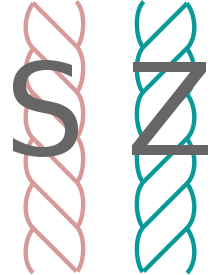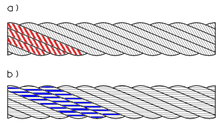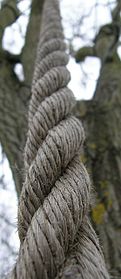Direction of impact
In knot science, the lay direction describes the orientation in which two or more lines are wound around each other.
S and Z beats
The direction of lay of ropes is often indicated with the capital letter S for the left-hand rope and the capital letter Z for the right-hand rope. The name comes from the similarity with the letters S and Z in which the windings run. With the S-lay, the turns run from the top left over the other rope to the bottom right, as with the letter S. With the Z-lay, the windings run from the top right over the other rope to the bottom left, as with the letter Z. This should be considered always the middle part of the letter.
- S-beat
- Z-stroke
Ropes can consist of several fibers, which in turn are made up of smaller fibers. For example, thicker wire ropes consist of strands, which in turn are made of wires. The direction of lay of a rope relates to the orientation of the largest components. In the example of the wire rope it would be the direction of the strands. The lay direction of the smaller components, such as the strands, can, however, also be indicated with a preceding small letter. For example, an sZ-lay corresponds to a wire rope with Z-lay strands and S-lay wires.
Left and right hand
Two lines wrapped around each other can be twisted either left -hand or right-hand. The naming follows that of the winding direction ( helicity ). The helix is left-hand (S-lay) when it winds counterclockwise (seen in the direction in which it is away from the viewer) and right-handed (Z-lay) when it winds clockwise (in the direction seen in which it moves away from the viewer). The lay direction is absolute, i.e. That is, it is independent of whether one is looking at the rope from above or from below along the axis.
Right and left hand rule
Left-hand ropes - in addition to S-lay - also with LH (for left hand) and right-hand ropes - in addition to Z-lay - also with RH (for right hand). The handedness follows the right-hand rule . If the rope is grasped with the right hand in such a way that the splayed thumb points to the axis of rotation (viewed in the direction in which the helix moves away from the viewer), the curved fingers indicate the direction of the winding. If you looked at the track a strand would run through a “right-handed helix”, as you know it from the thread of a normal screw . Left hand corresponding to the left hand.
Regular and lang lay
By adding " regular lay " (or "counter-blow") it is indicated that the outer wires are located on the rope surface approximately in the direction of the cable axis and the wires of the strands of the reverse direction follow as the strands in the cables (the stroke direction of the cable wires in the strand and the outer strands in the rope run in opposite directions).
By adding " long lay " (or "long-stroke") that the outer wires of the rope surface inclined strongly indicated, are to the cable axis and follow the wires of the strands in the same direction as the strands in the cables (the stroke direction of the cable wires in the The strand and the outer strand in the rope have roughly the same direction).
A right lay rope is, for example, a right lay rope, which in turn consists of right lay strands (marked as a in the picture).
Ordinary lay ropes are more suitable than lang's lay ropes for most applications: with regular lay ropes, external wire breaks usually occur earlier than with lang's lay ropes. This means a gain in safety, because a wire rope can only be discarded in good time if the rope is increasingly damaged by external wire breaks.
application
Individual evidence
- ↑ General information about wire ropes. (PDF) Retrieved May 19, 2016 .













